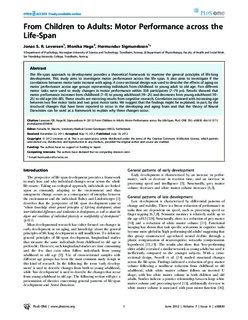| dc.contributor.author | Leversen, Jonas | |
| dc.contributor.author | Haga, Monika | |
| dc.contributor.author | Sigmundsson, Hermundur | |
| dc.date.accessioned | 2015-10-30T12:01:12Z | |
| dc.date.accessioned | 2015-11-25T10:06:35Z | |
| dc.date.available | 2015-10-30T12:01:12Z | |
| dc.date.available | 2015-11-25T10:06:35Z | |
| dc.date.issued | 2012 | |
| dc.identifier.citation | PLoS ONE 2012, 7(6) | nb_NO |
| dc.identifier.issn | 1932-6203 | |
| dc.identifier.uri | http://hdl.handle.net/11250/2365643 | |
| dc.description.abstract | The life-span approach to development provides a theoretical framework to examine the general principles of life-long development. This study aims to investigate motor performance across the life span. It also aims to investigate if the correlations between motor tasks increase with aging. A cross-sectional design was used to describe the effects of aging on motor performance across age groups representing individuals from childhood to young adult to old age. Five different motor tasks were used to study changes in motor performance within 338 participants (7-79 yrs). Results showed that motor performance increases from childhood (7-9) to young adulthood (19-25) and decreases from young adulthood (19-25) to old age (66-80). These results are mirroring results from cognitive research. Correlation increased with increasing age between two fine motor tasks and two gross motor tasks. We suggest that the findings might be explained, in part, by the structural changes that have been reported to occur in the developing and aging brain and that the theory of Neural Darwinism can be used as a framework to explain why these changes occur. | nb_NO |
| dc.language.iso | eng | nb_NO |
| dc.publisher | Public Library of Science | nb_NO |
| dc.title | From Children to Adults: Motor Performance across the Life-Span | nb_NO |
| dc.type | Journal article | nb_NO |
| dc.type | Peer reviewed | en_GB |
| dc.date.updated | 2015-10-30T12:01:12Z | |
| dc.source.volume | 7 | nb_NO |
| dc.source.journal | PLoS ONE | nb_NO |
| dc.source.issue | 6 | nb_NO |
| dc.identifier.doi | 10.1371/journal.pone.0038830 | |
| dc.identifier.cristin | 932096 | |
| dc.description.localcode | © 2012 Leversen et al. This is an open-access article distributed under the terms of the Creative Commons Attribution License, which permits unrestricted use, distribution, and reproduction in any medium, provided the original author and source are credited. | nb_NO |
